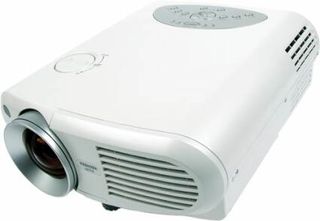Home Theater Cinema Paradiso With Video Projectors
Forget about expensive LCD TV screens: A digital video projector can do a better job for a whole lot less. A blank white wall and an investment of less than $1,500 can transform your living room into a movie theater minus the $10 plus tickets and obnoxious crowds. THG illustrates how now-affordable digital video projectors work as well as what to avoid.
Screens
You can project an on a white wall, a sheet, fabric or any other flat white surface. But the colorimetry will not be accurate. That's you should invest a little money in a good screen instead. Screen surfaces are designed to reflect the light with as much neutrality as possible. There are mechanical, electrical, and tensioned screens. Mechanical ones are the cheapest - over $300 for a 16/9 or 4/3 screen with 2.5-meter image base. For electrical models, the price quickly climbs to over $700. Tensioned screens are the most expensive, but also the most reliable where screen tension is concerned. They will be justified for those who can dedicate a room as their home theater. Prices are in the neighborhood of $700.
There are four major families of screens: matt screens, reflective or "high-gain" screens, rear-projection screens and acoustically transparent screens.

A high-gain screen doesn't really send back more light than it receives, it simply concentrates the light, recovering it from the edges, so to speak, and concentrating it in the center. The gain of a screen is the difference between the brightest and the darkest point (as for contrast). A surface with a gain of 1 returns the same quantity of light at all its points and reflects the light in all directions. A screen with a gain of 10 returns ten times more light viewed from the center as from its edges. If you choose a high-gain screen, you'll change the way different viewers see the image. People sitting at the sides will see less light than those sitting at the center. A screen with some gain must be used if you can't achieve sufficient blacks or if the contrast is too low.
Matt fabric is most often recommended because it offers perfect color balance.
Acoustically transparent screens have tiny holes that allow sound to pass through, which lets you place loudspeakers behind the screen.
Conclusion
As you've been able to see throughout this article, the purchase of a projector and screen is not a decision to be taken lightly. Prices have become quite affordable today, but the proliferation of models won't make your task easy. Follow this guide and you'll be able to choose the model that suits the use you'll put it to without breaking the bank. But above all, remember that demonstrations under real conditions are what will let you make the right decision.

Sign up to get the BEST of Tom's Guide direct to your inbox.
Get instant access to breaking news, the hottest reviews, great deals and helpful tips.
Most Popular

